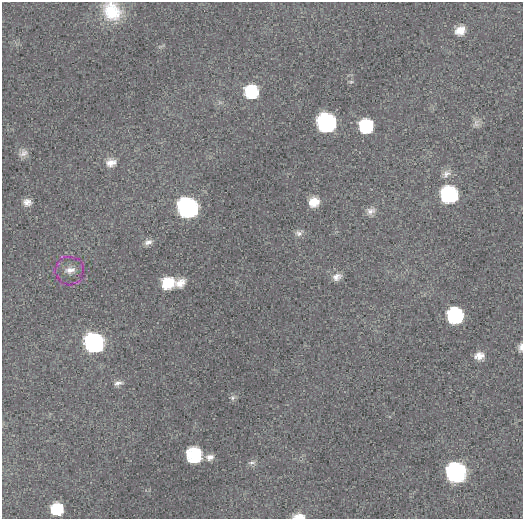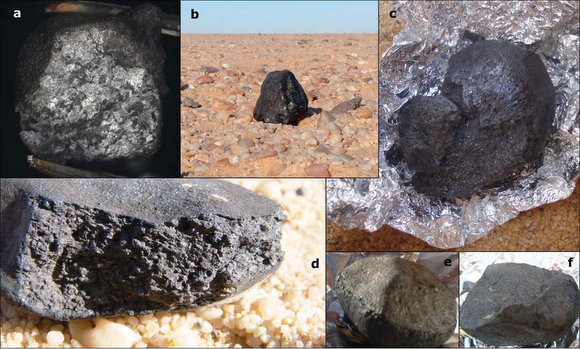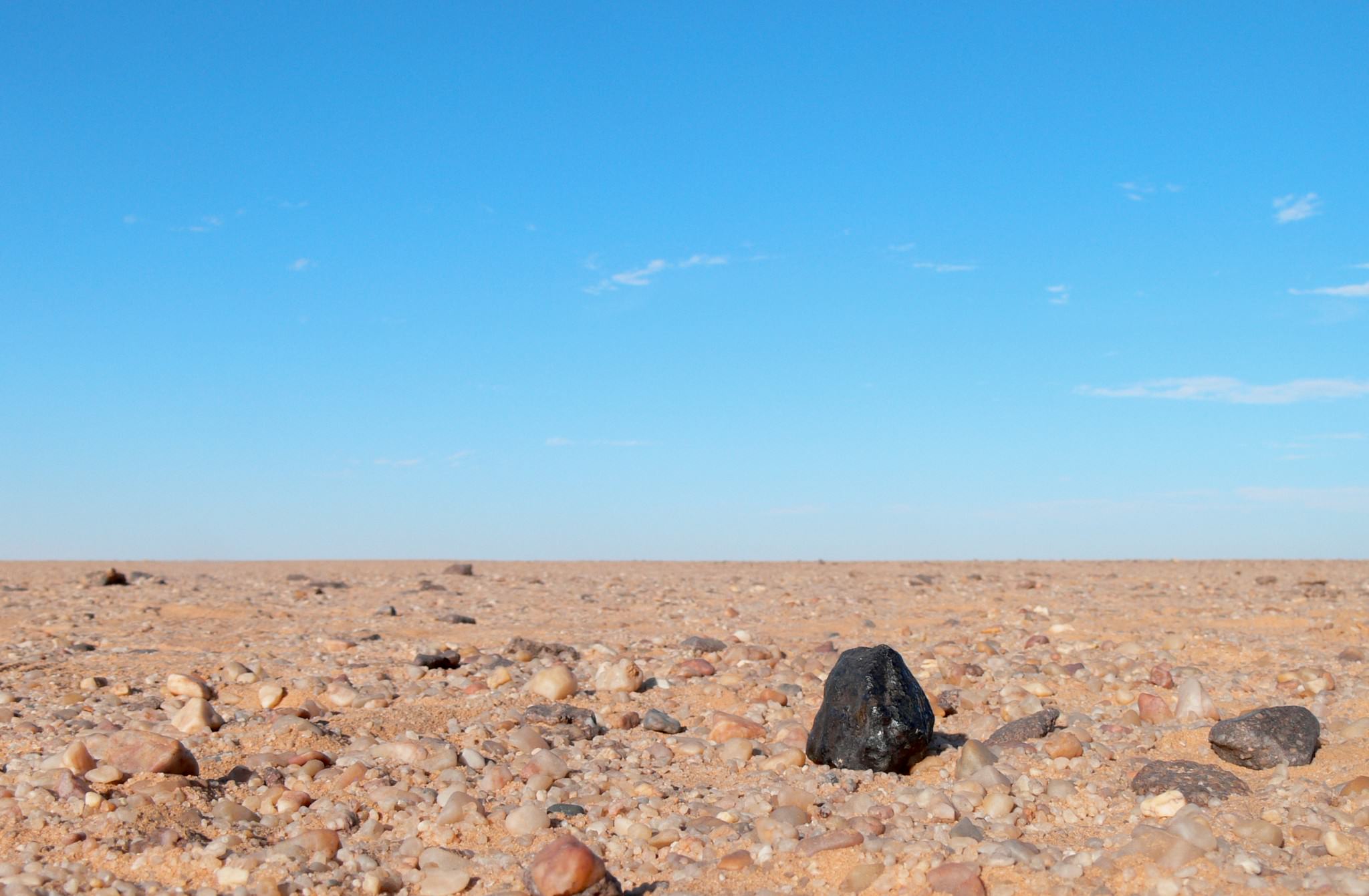[/caption]
It was an unprecedented event: On October 6, 2008, asteroid 2008 TC3 was spotted by the Catalina Sky Survey Telescope in Arizona. Plotting its trajectory, astronomers knew the 80-ton rock was heading for a collision course with Earth. Just 19 hours later, 2008 TC3 streaked over skies of northern Sudan and then exploded about 37 km above the Nubian Desert. This was the first time an asteroid was predicted – and predicted correctly — to impact Earth. Luckily, it wasn’t big enough to cause any problems, and its path brought it over a remote area. But this presented scientists with an exciting and unparalleled opportunity to possibly study fragments of an asteroid that had been spectrally classified before striking Earth.
Shortly afterwards, expeditions led by Dr. Peter Jenniskens, a meteor astronomer from SETI and NASA’s Ames Research Center, and Mauwia Shaddad, a physicist at the University of Khartoum, collected nearly 600 pieces of the asteroid strewn over 29 kilometers of desert. Altogether the meteorites weighed less than 10 kilograms – all that was left of the 80-ton asteroid.
But these fragments that fell to Earth are revealing secrets about the asteroid belt and the early days of the solar system, says Dr. Jon Friedrich from Fordham University, one of the many different researchers who have been studying pieces of the fragments, now called the “Almahata Sitta” meteorites.
“We can now say the asteroid belt has lots of different types of materials that give little snapshots of conditions within the early solar system,” Friedrich told Universe Today. “We’ve seen that these asteroids haven’t changed a whole lot since the Solar System formed, so it speaks to the diversity of the chemistry and the processes that were acting on these small bodies in the early Solar System.”
Scientists agree that understanding the composition of the asteroid belt is crucial to how we might deal with a larger asteroid that might be heading directly towards Earth.

Although scientists have been able to study and catalog many thousands of meteorites and have also analyzed hundreds of asteroids in space, this is the first time a “fresh” chunk of an asteroid that has fallen to Earth as a meteorite — and been analyzed through spectroscopy while it was still in space — has been found so quickly after hitting Earth. These meteorites are the first to be unequivocally connected with its parent asteroid.
“It is amazing to be able to finally positively link an asteroid to a certain type of meteorite,” said Friedrich. “When we look at asteroids in space we are only looking at the outside, and the asteroid’s surface has changed from being in the environment of space. For the first time we can study the interior of an object we have seen the exterior of in space. That knowledge gives us a map as to how the exteriors of asteroids change. We can have a better understanding of the population of objects in space and their distribution in the solar system.”
About three-quarters of meteorites that are found on Earth are an “ordinary” kind of stony meteorites called chondrites. Analysis of the Almahata Sitta meteorites revealed a rare, carbon-rich type of meteorite called an ureilite. Ureilites are believed to come from a large organic–rich, primitive asteroid that had melted sometime in its past.
“These are a strange type of meteorite which are rather odd in the sense that it is an igneous rock, much like a volcanic rock here on Earth,” Friedrich said, “so this meteorite’s origin is from a magma, so they were surely melted at one point. That also means they are like rocks you might pick up on Earth, but they also contain what we might call relatively primitive materials also, like graphite, organic compounds and other things.”
And so ureilites, and in particular the Almahata Sitta meteorites, contain material from both primitive and evolved types of asteroids.
There are few ureilites in meteorite collections, which is another reason the Almahata Sitta meteorites are so interesting. They have an unusually fine-grained and porous texture, making the meteorites extremely fragile. The researchers think that is why Asteroid 2008 TC3 shattered high in Earth’s atmosphere.
Friedrich and a student at Fordham, Julianna Troiano, studied fragments of the meteorites using an inductively coupled plasma mass spectrometer, which specializes in looking at inorganic composition of rock.
“We found chemically that all the different pieces were indeed ureilites,” Friedrich said, “but one other interesting thing was that these don’t seem to have any evidence of terrestrial contamination at all, which is what you would expect from such a ‘fresh’ fall. Most ureilite meteorites have been found in Antarctica, and oftentimes, the Antarctic samples seem to have concentrations that are somewhat elevated in certain elements, such are rare Earth elements like lanthanum, cerium. But the Almahata Sitta meteorites don’t seem to have an obvious contamination signature.”

This allows the researchers to better explore the solar system’s makeup.
While chondrites normally have not been modified due to melting or differentiation of the parent asteroid — and researchers suspect they are not necessarily representative of typical asteroid parent bodies — ureilites normally do show signs of the parent body being melted.
So what has happened to an asteroid that is has somehow been heated to the point of “melting?”
The latest research on the Almahata Sitta meteorites reveal that the parent asteroid was probably formed through collisions of three different types of asteroids. This would also explain why the meteorites contain both evolved and primitive asteroid materials.
Dr. Julie Gayon-Markt from the Observatoire de la Cote d’Azur in France also recently provided more insight on the family of asteroids from which 2008 TC3 originated.
“Because falls of meteorites of different types are rare, the question of the origin of an asteroid harbouring both primitive and evolved characteristics is a challenging and intriguing problem,” said Gayon-Markt, who presented her findings at the Europlanet Science Conference in October. “A workable explanation for how asteroid 2008TC3 could have formed involves low velocity collisions between these asteroid fragments of very different mineralogies.
Gayon-Markt and her team also looked at the dynamics and spectroscopy of asteroids in the main asteroid belt to shed light on the origin of the Almahata Sitta fragments. “We show that the Nysa-Polana asteroid family, located in the inner Main Belt is a very good candidate for the origin of 2008 TC3,” she said.
Primitive asteroids, which are relatively unchanged since the birth of the Solar System, contain high proportions of hydrated minerals and organic materials. However, many other asteroids have undergone heating at some point, probably through the decay of radioactive materials, and the molten magma has separated into an iron core surrounded by a rocky mantle.
Friedrich and Gayton-Markt are just two of the researchers who are studying the Almahatta Sitta meteorites to try and garner a better understanding of our solar system, as well as figuring out more about the asteroid that fell to Earth in 2008.
“The study of these meteorites has been interdisciplinary and collaborative, and our work is just a small piece of a greater puzzle,” Friedrich said.
Sources: Interview with Jon Friedrich, Europlanet Conference
Note: Almahata Sitta, which is Arabic for “Station Six,” a train station between Wadi Halfa and Khartoum near where the fragments were found.


Thanks for an interesting article, Nancy, and for raising awareness on this rocky subject. The Minor Planet Center played an important role in this story as we were able to accurately predict where 2008 TC3 would fall, only a few short hours after discovery.
This story highlights the importance of Near Earth Object surveys, which are poorly funded outside the US, and not as well funded as one would like here in the US. Then again, we scientists never think our projects are given enough funding 😀
—JL Galache
Minor Planet Center
“Altogether the meteorites weighed less than 10 kilograms – all that was left of the 80-ton asteroid.” So what exactly happened to the rest of the 80 tons?
It seems to me that the answer to this question would be important to studying the asteroid. If it burned, what did it combust with and what was formed? If it just exploded from the heat of entry, it would seem that the rest of the pieces should be there somewhere. Are we looking in the wrong places, or for the wrong things? Too many questions and too few answers.
Thanks for the update. .
Well,i am not a professional astronomer or physicist,but an asteroid would start burning up about 60-65 Kms above earth.Even though the atmosphere is extremely thin at that altitude,the speed of the asteroid ensures that it encounters enough molecules per second to initiate “burning” or incandescence,resulting in residue in the form of gases and smoke particulate which rapidly becomes denser as the asteroid drops in height.over the course of 30 secs it could travel a path of tens of Kms.
AFAIU my astrobiology textbooks, such descent and impact processes are areas of early studies. (I.e. several main hypotheses, models et cetera, but not a lot of established facts.)
“Too many questions and too few answers” is a fair summary of such a state as well. And that is another reason findings like these test hypotheses (observed spectra correlates with composition) or at least fill in blanks.
I’m not an expert on meteors either but AFAIK the material of the asteroid doesn’t burn away with some oxidizer but simply evaporates into a cloud of hot gas from the intense heat.
We can assume that much of the parent body was reduced to dust or ash in the fiery (Plasma hot temperatures) descent.
The fact that this meteor showed that it had once been molten is fascinating. I wonder how much of those type meteors are residuals from the impact that created the moon?
oh what’s the big deal. everything on earth is a result of outer space stuff